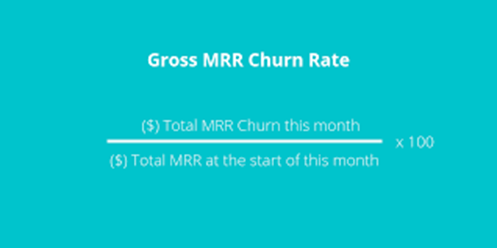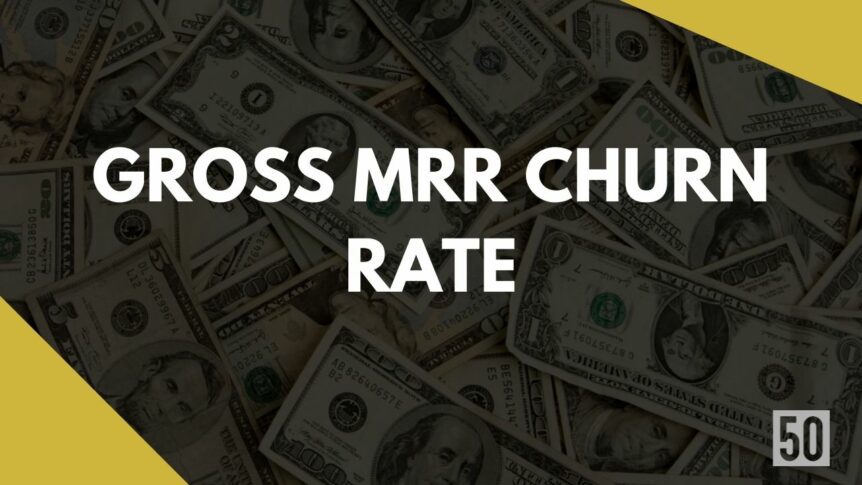Are you concerned about your company’s churn rate? Chances are, if you’re not taking steps to reduce it, you should be. This blog post will explore three methods for reducing your company’s gross MRR churn rate. Keep reading to find out more!
What Is A Gross MRR Churn Rate?
A company’s Gross Monthly Recurring Revenue (MRR) Churn Rate is the percentage of revenue lost each month due to customer cancellations or downgrades. In other words, it’s a measure of how much money the company is losing on a monthly basis.
The Gross MRR Churn Rate is important because it gives investors and analysts a clear picture of how well a company is doing. If the churn rate is too high, it means that the company is haemorrhaging money and is in danger of going out of business. On the other hand, if the churn rate is low, it means that the company is growing and is in good health.
While the Gross MRR Churn Rate is a good indicator of a company’s health, it’s important to keep in mind that it doesn’t take into account expansion MRR. For this reason, analysts also look at the Net MRR Churn Rate, which subtracts expansion MRR from the equation.
All in all, the Gross MRR Churn Rate is a valuable metric for measuring a company’s financial health. If the churn rate is too high, it could be indicative of serious financial problems.
Why Is It Important For Startups To Track This Metric?
Startups need to track their gross MRR churn rate for a variety of reasons. First, it’s a key metric for assessing the health of the business. Second, it can be used to identify problems early on and take corrective action.
Third, it can help startup founders make better decisions about product development, marketing, and sales. Finally, it can be used to benchmark the company against its competitors. In short, gross MRR churn rate is a critical metric for startups, and one that they should track closely.
How Do You Calculate Gross MRR Churn Rate?
To calculate your company’s gross monthly recurring revenue (MRR) churn rate, divide the total MRR that was lost or downgraded this month by the total MRR at the beginning of the month. Then, multiply that number by 100 to get a percentage.
For example, if your company had $100,000 in MRR at the start of the month and lost $10,000 in MRR due to attrition during the month, your gross MRR churn rate would be 10 per cent.
It’s important to note that this is a gross figure that doesn’t take into account any new MRR that was acquired during the month. To get your net churn rate, you’ll need to subtract any new MRR from the total MRR lost.

What Factors Affect The Gross MRR Churn Rate Of A Business?
The gross MRR churn rate of a business is determined by a number of factors, chief among them being the quality of the product or service being offered and the level of customer satisfaction. Other important factors include the company’s pricing strategy, its sales and marketing efforts, and the overall health of the economy.
Product or Service Quality
The quality of the product or service being offered is perhaps the most important determinant of the gross MRR churn rate. If customers are not satisfied with what they are receiving, they will be more likely to cancel their subscription or switch to a competitor. Poor quality products and services are often the results of shoddy workmanship or inferior materials. In some cases, the problem may lie with the company’s customer service department.
Pricing Strategy
Another important factor that can affect the gross MRR churn rate is pricing strategy. If a company’s prices are too high, customers may be tempted to switch to a competitor that offers lower prices. On the other hand, if prices are too low, the company may not be able to cover its costs and could eventually go out of business.
Sales and Marketing Efforts
The sales and marketing efforts of a company can also have an impact on the gross MRR churn rate. If a company is not effectively promoting its products or services, customers may not be aware of them and may therefore be less likely to subscribe. In addition, if a company’s sales team is not properly trained, they may not be able to effectively sell the products or services to potential customers.
Overall Health of the Economy
Finally, the overall health of the economy can also affect the gross MRR churn rate. If the economy is weak, consumers may be less likely to subscribe to a service or product. Conversely, if the economy is strong, they may be more likely to do so.
These are just a few of the factors that can affect the gross MRR churn rate of a business. In order to maximize subscription revenue, it is important for companies to carefully consider all of these factors and make sure that they are working in their favour.
What Is A Good Gross MRR Churn Rate?
Ideally, you want your churn rate to be as low as possible. A good gross MRR churn rate is typically below 5%. However, this will vary depending on your industry and business model as subscription-based businesses tend to have higher churn rates than product-based businesses.
For example, in our latest analysis of data from different SaaS businesses, we found that the lower your business’s average revenue per account (ARPA) will be, the higher will be the churn rate.
If a SaaS business is making less than $10,000 of MRR then it can expect a relatively high churn rate, for instance, 8–9% per month. However, once the business acquires approximately $10,000 in MRR, the churn rate stabilizes to 4–5% per month.
What Is A Bad Gross MRR Churn Rate?
A bad gross MRR churn rate is anything above 5%. This means that for every $1,000 in monthly recurring revenue (MRR), you’re losing more than $50 each month. A high churn rate is one of the main indicators that a business is in trouble.
It can be caused by a number of factors, including poor customer service, inadequate product quality, and high prices. In order to turn things around, businesses need to identify the root cause of their high churn rate and take steps to correct it. Otherwise, they’ll continue to lose customers and eventually go out of business.
Average Gross MRR Churn Rate Across Different Industries
Now that we know what gross MRR churn rate is, let’s look at some examples of gross MRR churn rates across different industries.
SaaS
Gross MRR churn for a typical SaaS company is between 5-7%. This means that for every $1 in monthly recurring revenue (MRR), the company is losing $0.05 to $0.07.
eCommerce
Gross MRR churn for an eCommerce company is usually between 2-3%. This means that for every $1 in monthly recurring revenue (MRR), the company is losing $0.02 to $0.03.
Subscription Boxes
Gross MRR churn for a subscription box company is typically between 10-15%. This means that for every $1 in monthly recurring revenue (MRR), the company is losing $0.10 to $0.15.
Content creators/ Publishers
Gross MRR churn for a content creator or publisher is typically between 3-5%. This means that for every $1 in monthly recurring revenue (MRR), the company is losing $0.03 to $0.05.
Online Courses
Gross MRR churn for an online course company is usually around 7-10%. This means that for every $1 in monthly recurring revenue (MRR), the company is losing $0.07 to $0.10.
As you can see, the gross MRR churn rate varies depending on the industry. SaaS companies have a higher churn rate than eCommerce companies, for example. And subscription box companies have a higher churn rate than online course companies.
Strategies To Decrease Your Gross MRR Churn Rate
No matter how much you’ve grown your business, chances are gross MRR churn rate is still a metric you’re keeping a close eye on. After all, it’s a key indicator of customer satisfaction and can have a major impact on your bottom line.
If you’re looking for ways to decrease your gross MRR churn rate, here are a few strategies to try:
1. Increase customer satisfaction
One of the best ways to decrease the gross MRR churn rate is to increase customer satisfaction. After all, satisfied customers are less likely to churn. There are a number of ways to increase customer satisfaction, but some common strategies include improving customer support, providing more value, and increasing transparency.
2. Improve customer retention
Another effective strategy for decreasing the gross MRR churn rate is to improve customer retention. When customers feel valued and supported, they’re less likely to churn. There are a number of ways to improve customer retention, but some common strategies include providing more value, increasing transparency, and improving customer support.
3. Increase transparency
Increasing transparency is another effective strategy for decreasing the gross MRR churn rate. When customers feel they understand what they’re paying for and why, they’re less likely to churn. Some ways to increase transparency include providing more information about features and benefits, being upfront about pricing, and clearly explaining terms and conditions.
4. Be upfront about pricing
Being upfront about pricing is another key way to decrease the gross MRR churn rate. When customers feel they understand the value they’re getting for their money, they’re less likely to churn. Some ways to be upfront about pricing include clearly explaining price changes, providing discounts and coupons, and being transparent about billing.
5. Provide more value
Providing more value is another effective strategy for decreasing the gross MRR churn rate. When customers feel they’re getting their money’s worth, they’re less likely to churn. There are a number of ways to provide more value, but some common strategies include adding new features, improving customer support, and increasing transparency.
By implementing these strategies, you can decrease your gross MRR churn rate and improve your bottom line.
Conclusion
Finally, keep in mind that it’s never too late to turn your company’s gross MRR churn rate around. By following the tips and tricks we outlined in this blog post, you can start seeing a decrease in your company’s churn rate in no time

